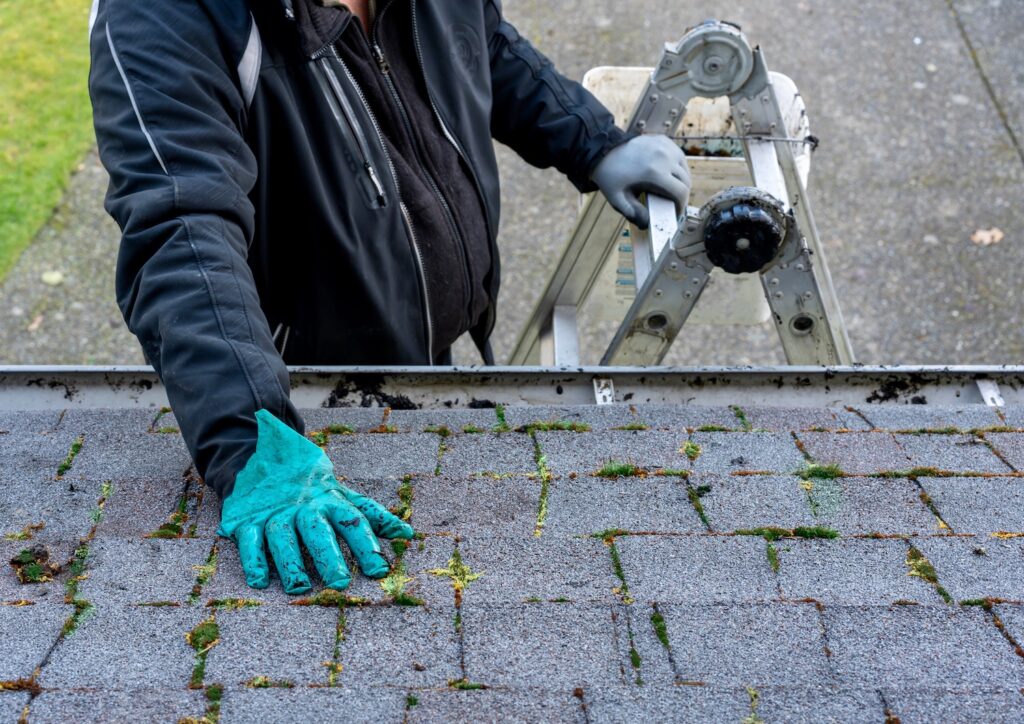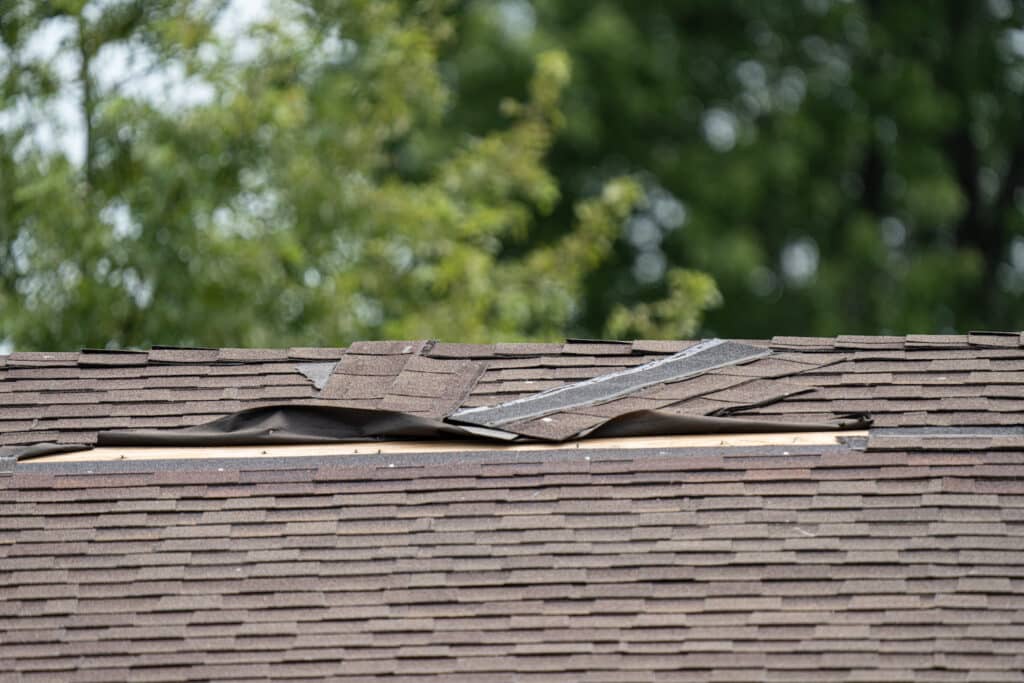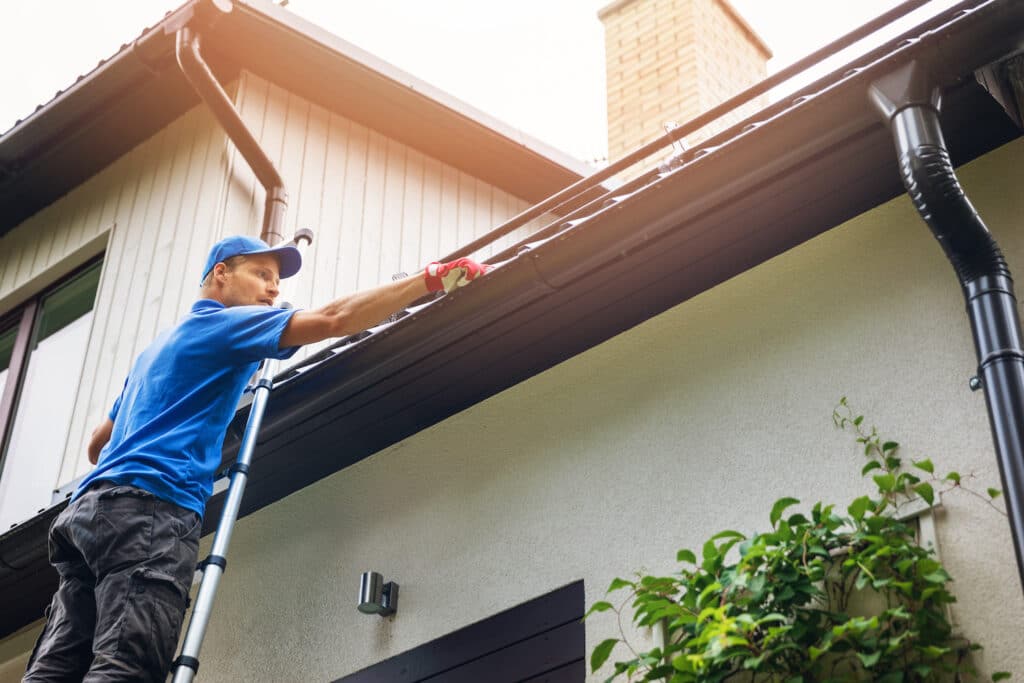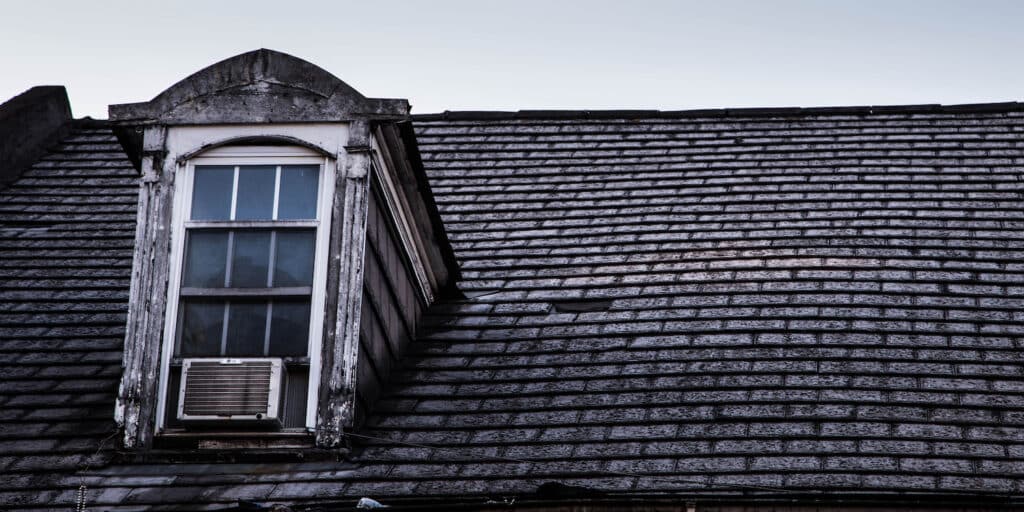Breakdown By Material & Region
We all wish our home’s roof could last forever, but sadly that’s not the case. However, a roof can last well past its intended lifespan if you:
- Invest in a premium material
- Live in an area with less damage risk to your home
- Keep up with regular maintenance.
Because your roof is a critical part of your home (or business), it’s important to make sure you choose the right material for your climate and region. That way it can last longer and you’ll get the most out of your investment!
Today, we’ll answer the question, “how long does a roof last?” We’ll break down how long each type of roofing material lasts on average, and how long they last in different parts of the country. We’ll also discuss some hands-on tips for prolonging the life of your roof.

How Long Does a Roof Last by Material?
There are numerous roofing materials to choose from for your home, ranging from standard to premium options. Each has unique durability and lifespan, so it’s important to know what you’re getting when you install a new roof. Some examples of roofing materials and their lifespans include:
Asphalt Shingles: 15-20 Years
Asphalt shingles are the most commonly installed roofing material in the United States. This is most likely because of its affordability, and less about its lifespan. While they only last for about 25-30 years, they are very affordable to replace if you aren’t too concerned about long-term investments or want a quick fix. The benefits of asphalt shingles include:
- Affordable (Approx. $5,000)
- Easy to install and maintain
- Easy to repair (can replace just one damaged shingle)
Architectural Shingles: 30-50 Years
Architectural shingles are a more premium option of a standard asphalt shingle. They are more durable and have more dimensions and color options for homeowners looking to upgrade their average roof to one a little longer-lasting.
- Can withstand winds up to 120mph
- Look like a premium roof (more than asphalt shingles)
- Cost-effective
Cedar Shakes: 30-35 Years
Cedar shakes are a natural roofing material made of, you guessed it, cedarwood. They give off a rustic vibe and can be treated to last even longer than the average 30-35 years. Cedar shake roofs have many benefits:
- Aesthetically pleasing
- Can be re-treated and stained to last longer
- Fire and fungus resistant
- Natural insulator
Clay Tile: 50-100 Years
Clay tile is most commonly found in southern states in a desert climate because it can keep homes cooler during extreme heat. They also last a lot longer and are a great investment, particularly since those states don’t experience as many storms or other damaging weather to their roofs.
- Long-lasting
- Highly durable
- Fire-resistance
Concrete Tile: 50-60 Years
Like clay tile, concrete tile is a great roofing material for hot and dry climates. Sometimes concrete and clay tile roofs can seem interchangeable, as concrete may be used to create a duplicate of clay tile, with the same look but added benefits.
- Very low maintenance
- Energy-efficient
- Come in a wide array of color options
- Often come with 50-year warranties
Metal Roofs: 40-75 Years
Metal roofs can come in multiple variations such as panels, shingles, and sheets. No matter what version of a metal roof you have, you can expect a longer lifespan than other types. Plus the following benefits:
- Great ROI (Return on Investment)
- Completely fire-resistant
- Environmentally friendly— made of recyclable material
- Energy-efficient
- Stunning curb appeal
Slate Tile: 100+ Years
A slate roof is considered one of the longest-lasting roofing materials and is often called “The Forever Roof”. Its lifespan often outlasts the home it’s installed on! This is likely because slate is a natural material that can withstand any type of extreme weather conditions.
- Lasts virtually forever
- Saves on waste
- Fire, water, insect, and wind-resistant

Factors That Lessen Your Roof’s Lifespan
An intended lifespan is just an estimation based on data and how long most roofs last based on their durability and manufacturing. However, there are many factors that can reduce how long your roof lasts.
Poor Installation
If your roof isn’t installed correctly, it’s likely that it will have a shorter lifespan. Make sure you find a reputable contractor to install your roof and that they use the correct materials for your home.
Inadequate Attic Ventilation and Insulation
Your attic is just as important to the health of your roof as the shingles or tiles on top. If there’s not enough insulation or ventilation, it can cause your roof to overheat and deteriorate faster.
Poor Maintenance
It’s important to have your roof checked and serviced regularly to ensure that any small problems are fixed before they turn into bigger, more expensive ones.
Failed Repairs
DIY repairs might sound enticing— after all, you might save money fixing it yourself. However, inexperienced homeowners are not roofers, so attempting to repair your roof yourself can only bring more problems. It can even void your warranty. So tread lightly if you are trying to repair your own roof.
Where You Live + Exposure to the Elements
Certain climates can be harsher on your roof than others. For example, if you live in a hurricane-prone area, your roof will have to withstand high winds and flying debris. If you live somewhere with severe winters, your roof has to deal with large amounts of snow and ice. And if you live in an area with a lot of trees, your roof is more likely to experience damage from falling limbs.
All of these factors play a role in how long your roof will last. By taking into account the material of your roof and the climate you live in, you can get a better idea of how long it should last. With proper installation, maintenance, and repair, you can extend the lifespan of your roof and enjoy it for years to come.
What Weather Contributes to the Most Roof Damage?
One of the quickest ways to age your roof is to have it faced with extreme weather on a consistent basis. And with nearly 8 of the top 10 causes of roof damage being weather-related, that’s something to pay attention to. And different regions in the country have very different weather patterns which are important to consider when investing in a new roof.
You’ll want a roofing material that can withstand the climate and weather you experience, and it’s important to know how it will be affected. Here are the weather conditions that will most wreak havoc on your roof.

Heavy Rain ⛈
Heavy rain and precipitation is something that can pummel your roof season after season, bringing much wear and tear to your roofing materials. The Midwest Region sees more precipitation in more forms than most other regions. This region will bring thunderstorms, rain, snow, ice, and humidity— all bringing moisture and excessing water to your home’s roof. The states in this region include:
- Illinois
- Indiana
- Iowa
- Kentucky
- Michigan
- Missouri
- Ohio
- Wisconsin
You can also expect heavy rain and moisture in the Northwest Coastal Region with Washington and Oregon, plus the High Plains Climate that includes Minnesota and the Dakotas. All of these states could ensure their roofs are properly sealed, and well-insulated. Homeowners should check their roof and roof flashing regularly for damage, and consider a metal roof that can withstand greater amounts of rain and snow.
Strong Winds
While most of the country experiences some form of severe weather, the Southeast and Gulf Coast areas are especially vulnerable to hurricanes. If you live in this region, it’s important to have a roof that can withstand heavy winds— up to 140 miles per hour. Again, metal roofs are probably your best bet as they are rated to withstand hurricane-force winds of up to 160mph.
Hailstorms ⚪
The midwest and high plains regions also see hailstorms— and may be one of the only regions to experience this phenomenon. While large hail is quite rare, it only takes a small dime-sized hail with enough wind force behind it to dent your shingles. Some asphalt or architectural shingles are built to withstand such force which can help alleviate the pain of a leaky roof. Plus, when a hail storm does strike, if it only damages a small portion of the roof, it’s easy to replace those shingles vs. a total roof replacement.
Snow and Ice ⛄
While the Midwest and Northeast regions are known for their snowfall, any region in the country can experience a cold snap that brings snow or ice. And with that comes the potential for an ice dam to form on your roof. This happens when heat from your home melts the snow on your roof which then refreezes at the edge of your roof, causing a giant ice dam. Re-insulating your roof or replacing it if it’s old can help alleviate ice dams and keep them from coming back.
Also, be mindful that while snow itself isn’t necessarily damaging, when it melts it can be. So if you have a ton of snow up on your roof, scheduling professional snow removal can help prevent excess water and remove that added weight from your roof.
Natural Disasters
Of course, natural disasters like tornadoes and hurricanes can cause massive damage to your roof. But, if you live in an area that’s prone to such disasters, there are some steps you can take to help fortify your home— and your roof.
For example, if you live in an area that experiences hurricanes, making sure your roof is properly fastened and using hurricane clips can help keep it from being ripped off in high winds. For areas with tornadoes, having a metal roof can help as they are often the only roofs that remain after a twister hits.
In short, there are many things that can affect how long your roof will last. But, by taking into account the materials used and the climate you live in, you can get a good idea of how long to expect your roof to last.
Tips for Prolonging Your Roof’s Lifespan ✅
An expected lifespan is only that— an expectation. But it’s up to homeowners to do the additional work to maintain and repair their roofs when needed. A poorly maintained roof will age faster and cause more widespread damage than one that is checked regularly. No matter what kind of roof you have, there are some general tips that can help prolong its lifespan.
- Clean your gutters regularly to ensure proper drainage.
- Inspect your roof annually and after severe weather to check for damage.
- Make sure your attic is properly ventilated to reduce heat and moisture.
- Trim trees and remove branches that could fall on your roof during a storm.
- Replace damaged or missing shingles as soon as possible.
- If you notice any leaks or damage, don’t put off those repairs.
- Additionally, know the signs of a roof leak (spots on the ceiling, wet attic floorboards, deflated insulation) so you can act fast.
- Sign up for a maintenance plan with your local roofer that includes inspections and minor repairs.
- Don’t DIY repairs unless you’re experienced. Failed repairs can cause more issues and even void warranties.
- Regularly repair or replace your flashing and caulk around chimneys, skylights, etc.

Ensure Your Roof’s Durability With Proper Installation
The #1 thing you can do to ensure your roof lasts is to get it installed properly. And a reputable team like Apple Roofing can make sure that happens.
When you work with the expert team at Apple Roofing, you get reliable customer service, outstanding installation, and ongoing support for your roof. If you’re concerned about how your roof will stand up to the elements, reach out to us for a FREE estimate. We can discuss your options and come up with the ultimate roofing solution for your needs.

